This website is supported by its readers. If you click one of my links I may earn a commission. I am also a participant in the Amazon affiliates program and I will also earn a commission from qualified purchases.
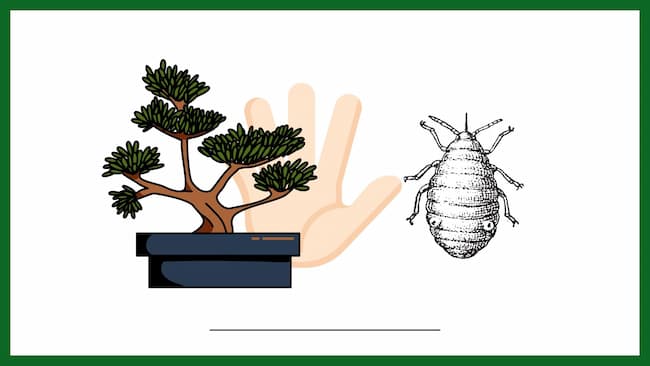
Recently, I was pruning my Chinese Elm bonsai tree, which I’ve been keeping outdoors this summer due to warm temperatures. I noticed, however, that some of the leaves were a little bit sticky to touch, so naturally, I got slightly worried. So why does my bonsai tree have sticky leaves?
The main reason for sticky leaves on your bonsai tree are aphids. Aphids leave a sticky substance called honeydew on the leaves and bark of your tree. If left unchecked, aphids can severely damage the health of your bonsai, regardless of species.
So, can any other bugs cause sticky bonsai leaves? And are some bonsai species more susceptible to heaving sticky leaves? Keep reading to find out more!
Just a quick heads up, over the past three years of running Plantpaladin, hundreds of people have asked for product recommendations. As such, You can find my favorite indoor bonsai tree here (link takes you to Bonsaiboy), my favorite outdoor bonsai tree (link takes you to Bonsaiboy), or have a look at all the products I recommend here.
Why does my bonsai tree have sticky leaves?
Now, as I mentioned, having a bonsai tree develop sticky leaves all of a sudden was a little bit worrying, so to get to the bottom of why, I visited my local botanical garden, spoke with a few excerpts there, and even surveyed 20 plant paladin readers who suffered the same thing asking them what the cause was.
To summarise:
- Undoubtedly, the most significant cause of sticky leaves would have to be Aphids.
- Aphids are small sap-sucking insects that are also known as greenflies.
- These insects then frequent bonsai tree leaves, ingesting the sap from the leaves and bark of the tree.
- As they ingest the leaves, they secret a sticky substance called honeydew on the tree, making it difficult to touch.
- The more aphids your tree has, the sticker it will become.
- Aphids will kill your tree, so it is essential to either blast them with water or use a pesticide to remove them.
- Aphids, sadly, are not the only bugs that can damage your bonsai tree and leave a sticky substance, with caterpillars, Spidermites, Whiteflies, Scale, and Mealybugs all producing the same honeydew.
- To prevent this, regularly check your bonsai tree for signs of insect infestation and consider investing in natural predators like wasps or ladybugs.
- Bonsai trees with larger or denser leaves, such as Fukien tea trees, are much more likely to be impacted than conifers, such as Junipers or Pine bonsai.
This is a lot of information, so let’s break down how to prevent your bonsai from getting sticky leaves.
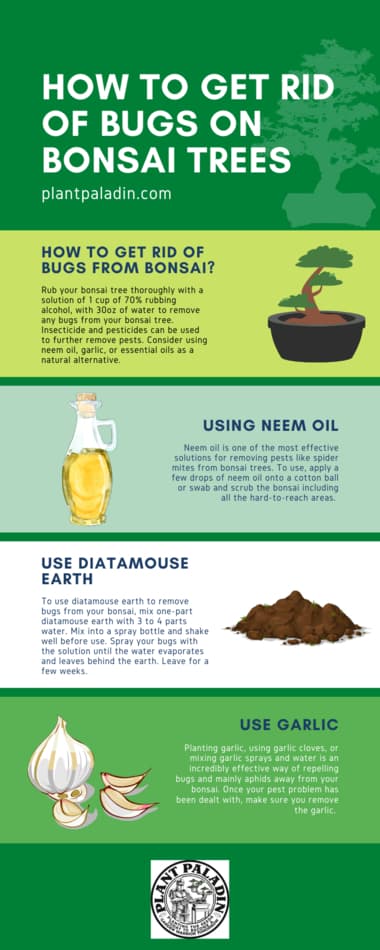
How do I know what insects have attacked my tree?
So, as you can imagine, there are a lot of insects that can cause damage to your tree.
While most of them can be removed and treated the same way, there are subtle differences in how to deal with them.
For example, scale infestations usually respond better to a soap and vinegar mix; aphids can be blasted off with water.
As such, I’ve pulled together a table below showing the critical characteristics of the different insects and how to identify them:
Pest Type | Appearance | Key Characteristics |
Scale | Tiny, flat, or dome-shaped insects that often resemble small shells or bumps on plant surfaces. | Hard, protective shell (scale) covering their bodies. Immobile once they settle on a plant. Feed by piercing and sucking plant sap. |
Aphids | Tiny, soft-bodied insects that come in various colors and have pear-shaped bodies, often green, brown, or black. | Antennae and two tubelike structures (cornicles) on their rear ends. Rapid reproduction and the secretion of honeydew. |
Mealybugs | Are small, soft-bodied insects covered in a white, powdery wax, with oval-shaped bodies. | Antennae and short legs. Feed by piercing plant tissues and excreting honeydew. |
Borers | Larvae of various insect species that bore into plant stems, trunks, or roots. | Larvae are typically caterpillar-like in appearance. Create tunnels or galleries inside plant tissues. Can cause structural damage and weaken plants. |
Caterpillars | Larval stage of moths and butterflies with long, segmented bodies, multiple pairs of legs, and often distinct colors, patterns, and hairs. | Herbivorous, feeding on leaves and plant parts. |
How to stop aphids from causing sticky bonsai leaves
So now we know the main insects that cause sticky bonsai leaves, how do we prevent them from attacking your tree?
Let’s start then with the biggest culprit – Aphihds.
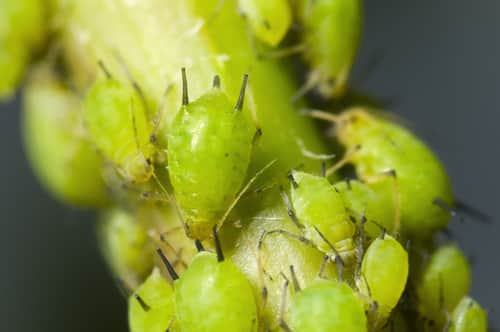
Aphids are, without a doubt, the most common insect you will need to deal with as a bonsai tree owner.
These insects come in various colors ( black, green, white), will secret honeydew, and eat all your bonsai tree leaves without hesitation.
Using the following methods to prevent aphids from attacking your bonsai is vital.
Soapy water to remove aphids from bonsai.
My favorite method of removing aphids from bonsai is using a mix of soapy water and spraying your bonsai.
What I like best about this method is that it is relatively inexpensive.
It uses items that can be regularly found around the house.
Better yet, as you will be using household items, it leaves away no toxins and is not harsh to humans – keep the spray away from your eyes.
To do this, then:
- Move your bonsai away from the others in your collection so the other plants do not get infected.
- Fill a bowl with 30 oz of water.
- Fill another bowl with two tablespoons of liquid soap.
- Mix thoroughly.
- Pout into a nozzle spray bottle.
- Swab a small section of your tree with the spray first to see if there is no reaction – you will need to wait 48 hours for this.
- If there is no reaction – spray your bonsai thoroughly. On and under the leaves, on the steps, and apply a layer on the topsoil
- Wait 24 hours to dry.
- Then, after 7 to 10 days, redo the method to eliminate any eggs or aphids you missed.
This method works partially well in the 40 to 90-degree Fahrenheit range or (4 to 32 degrees Celsius), so it is ideal to use from spring to fall.
Using the liquid spray will also wash away any sap on your tree, meaning it will be less likely that other aphids will nest as they are attracted to this sap.
How effective is it at removing aphids: 9/10
Neem oil to remove aphids
Neem oil is another common and ancient method to remove aphids and other pests from bonsai.
The neem tree has been used for multiple purposes not only in the Indian subcontinent but worldwide for almost 4500 years, and so its properties work as a natural aphid killer.
Neem oil is one of the most effective solutions for removing pests like aphids from bonsai trees.
Apply a few drops of neem oil onto a cotton ball or swab and scrub the bonsai, including all the hard-to-reach areas.
Once your aphids have been removed, wash your bonsai to remove any excess oil that, if left on for too long, can damage your plant.
Why is neem oil good to use for aphid removal?
One of the reasons I love using neem oil is because it, too, is 100% natural.
The EPA has recognized it as a pesticide that does not cause adverse effects in humans.
Neem oil is also OMRI listed, an accrediting body in the USA that lists only organic produce.
Neem oil won’t harm good bugs like bees, only affecting aphids and other pests.
Top tips for using neem oil to remove aphids
Some top tips for using neem oil would be as follows:
- Apply neem oil after sunset, as it can cause your plant to overheat if you do so
- Opt for a brand that is 100% organic, at around 70% concentration
- Ensure your neem oil contains Azadirachtin, an active ingredient in neem trees.
If you are interested in my recommendation for neem oil, it would have to be the Harris Neem Oil (link takes you to Amazon), which has been 100% cold-pressed and is super easy to mix.
How effective is it at removing aphids: 8/10
Rubbing alcohol and water
While it might not seem like it to us, rubbing alcohol is a potent insecticide and is particularly effective against Aphids.
Rubbing alcohol that is around 70% works best and dissolves the Aphid’s outer shells.
How to use:
- Move your bonsai away from the other trees in your collection.
- Get 1 cup of 70% rubbing alcohol.
- Fill up a bowl with 30oz of water.
- Mix these items in a bowl.
- Once mixed, pour into a spray nozzle
- Spray your bonsai thoroughly in all the hard-to-reach areas – your bonsai should be dripping wet.
- Once completed, let your bonsai soak for 24 hours.
- The rubbing alcohol should kill off most bugs; however, if you still find a few, you can repeat this process twice or thrice.
As bonsai sometimes have hard-to-reach areas, sometimes using cotton wool is a more effective method.
How to use rubbing alcohol and cotton wool to remove aphids
- Pour 70% rubbing alcohol into a cotton ball.
- Using this cotton ball, rub down each leaf, branch, and twig of your bonsai and all the hard-to-reach areas, such as the underside of leaves.
- Target the Aphids directly that are easy to spot.
- Once completed, pour rubbing alcohol into a cotton swab to get into your plant’s nooks, which is much easier than using a cotton ball.
- Finish off by pouring the rubbing alcohol into a paper towel and wiping down the side of your plant pot, which can be a breeding ground for insect eggs.
Studies have found this works against aphids and other bugs, so keep some in your pantry.
How effective is it at removing aphids: 8/10
Now, there are also a few other ways to remove aphids from your bonsai tree, which I have covered in my specifics post, but the table below should help summerise this:
How to remove Aphid
Method
Liquid soap and water
Mix two tablespoons of regular supermarket liquid soap with 30oz of water. Pour into a spray bottle and thoroughly spray the leaves of your bonsai
Neem oil
Pour a few drops of neem oil into a cotton ball or swap and thoroughly scrub the bonsai leaves and all hard-to-reach areas.
Rubbing alcohol and water
Use one cup of 70% rubbing alcohol and mix with 30oz of water in a bowl. Then, either pour into a spray bottle or, using cotton wool, apply to all the bugs
Insecticide sprays
Move your bonsai into an outdoor open space and then spray thoroughly with the insecticide. Wait for the allocated time for your spray before bringing it back inside.
Parasitic insects
Lady beetles are the natural predators of aphids, so introducing them where you keep your bonsai will naturally eat any aphids – once the aphids have been removed, you can store the Beatles somewhere else for your next removal.
Manually remove the bugs
Get a paper towel or scrap paper. Then, manually tap the aphids until they fall on the paper. Aphids can also be removed by using a thick brush to rub your bonsai down.
Vinegar
Mix one cup of water with one cup of vinegar and pour in a spray. Then, thoroughly spray the bonsai to remove the aphids.
Water blasting
Place your bonsai outdoors. Then blast with water from a jet washer to blast the aphids away.
How to stop the scale from causing sticky bonsai leaves
The other insect that will attack your bonsai tree and leave a sticky substance is scale.
Scale are small shell-like insects that attach themselves to plants, usually on the leaves and stems. They typically appear as brown shells and feed on the dew some plant breeds give off. Left untreated, they can cause an infestation and severely damage your plant.
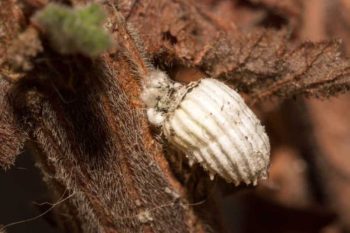
How do you prevent scale on your bonsai tree?
Now, to prevent scale from your bonsai tree, you will need to do the following:
Remove any leaves that are too far gone.
This step will be tricky for some of you.
While preening and grooming our bonsais is part and parcel of the job, removing leaves and branches we don’t want to get rid of can be challenging.
That sad truth is that if the scale is too far gone in some of your leaves, prevention will be too late, and so to protect the rest of your bonsai, we may need to remove the leaves.
To remove, cut the leaves as close as possible to the branch or stem and dispose of the dead leaves.
Rub your bonsai with rubbing alcohol.
Once any too-far-gone leaves have been removed, we must deal with the rest of the scale.
The best option is to get 70% rubbing alcohol ( which works best) and dip a cotton ball into the alcohol.
You will then need to remove the scale from your plant, which will help immediately burn the scale off.
Some scale can be tricky, so you want to use some force if it only partially removes some of the scale. You also want to make sure you are rubbing down the front and the back of your plant, which can be easily forgotten.
Now, it’s not just the leaves you want to rub down but all areas, including
- The leaves
- The stems
- The branches
- The root
- The plant pot/planter
- Any moisture tray you use
- Topsoil
For the harder-to-reach spots, doing bonsai is the entire plant. Use a cotton swab to wipe down these areas successfully.
It can be challenging to remember things like rubbing down the topsoil, where your plant meets the soil, and the rim of your plant pot/planter, but this is where eggs start growing from, so it is worth rubbing down.
To rub down these more extensive areas, get a napkin or tissue, use a small amount of rubbing alcohol, and wipe down these larger surface areas.
Create a cleaning solution.
Once your bonsai has been wiped down with rubbing alcohol, the next stage is to mix a solution to spray on your bonsai that will remove any spots you have missed and will protect your bonsai in the future.
To create the solution, you will need:
- 1 cup of 70% rubbing alcohol
- 1.5 teaspoons of liquid soap
- 30 OZ of water
Mix these items until they are emulsified, then pour the solution into a spray bottle.
“Most bonsais develop scale infestations at some point in their lives, and yet by following these steps, you can prevent any significant damage to your tree.”
Spray your solution on your bonsai.
Now, the fun stuff!
Get a cover, as things will start to get messy to put on the table you are working from.
Shake your spray bottle and spray your bonsai tree thoroughly with your new solution.
Try to coat each leaf if possible if the leaves of your bonsai are long enough.
The key here is to try to get the solution to drop down the leaves, so don’t worry about using too much. You want your bonsai to be soaking wet after this.
Aim for all the cracks and crevasses again – take your time with this, as they can be hard to get.
You can also lightly spray the topsoil, but the aim here is to get the leaves, typically the most infested when it comes to scale.
Then, leave your plant to dry.

How do you remove other bugs from your bonsai that cause sticky leaves?
So, while aphids and scale will be the two biggest culprits, as mentioned, caterpillars, borers, and spider mites will all and can all cause your leaves to become sticky.
Thankfully, the methods above will work successfully at removing them.
That said, I recommend checking out my post on how to remove bugs from a bonsai tree.
To summarize here quickly, you can remove these bugs from your bonsai by:
- Using a solution of rubbing alcohol and water
- Using rubbing alcohol and cotton wool
- Using neem oil
- Using pesticides and insecticides
- Using garlic
- Using essential oils
- Using water bags
- Using diatamouse earth
- Using vinegar
- Water blasting
- Parasitic wasps and insects
- Manually removing the bugs
What is the sticky substance on my Fukien Tea bonsai tree?
A sticky substance commonly found on Fukien Tea bonsai trees is honeydew. Aphids and scale secrete this sticky substance and can damage your bonsai. Remove these insects to prevent your Fukien Tea bonsai from getting sticky leaves in the future.
How to tell if your bonsai tree has sticky leaves?
The most significant way to tell if your bonsai tree has sticky leaves is to touch the leaf surface.
If it is sticky or a white sticky discounted substance is on your leaf, this is a surefire sign that your bonsai has been infected with aphids.
Ensure then that you regularly check your bonsai tree at least once weekly for signs of bitten leaves on the edges, small eggs in the potting soil, and scale or aphids hissing on the underside of your leaves.
What bonsai trees are more likely to have sticky leaves?
Deciduous bonsai trees such as Chinese Elm or Fukien tea that are kept outdoors are much more likely to develop sticky leaves than conifers. This is because these bonsai usually have large leaves that attract insects if kept outside during warmer conditions.
Why does my bonsai tree have sticky leaves? – Survey results
Finally, as mentioned, I contacted 20 plant paladin readers, asking them why their bonsai trees have sticky leaves.
To summarise:
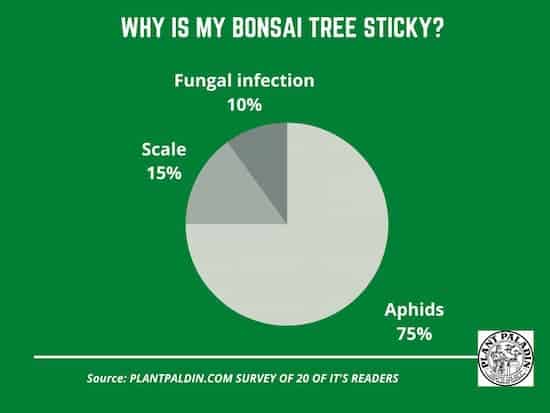
My top picks for the gear you will need!
So like I mentioned earlier, over the past three years of running PlantPaladin, hundreds of people have asked me for my recommendations on the best bonsai gear on the market.
Having spent thousands of dollars on bonsai items these past few years and tested at least 100 bonsai-specific products, I’ve listed my favorite products below – All of which I highly recommend and think you can get great value.
They can purchase directly by clicking the link to take them to Amazon.
Bonsai Tool Set: One of the significant challenges I’ve had is finding a toolset that was not only durable but didn’t break the bank. SOLIGT has recently developed a fantastic bonsai tool set that covers all the tools you need to trim, prune, and repot your trees. – You can grab it here.
Complete Bonsai Set: Many of you will want to grow your bonsai trees entirely from scratch, but finding the varicose seeds, pots, and other items in one place can be challenging. Leaves and Sole then have created a complete bonsai set that I’ve personally used that ticks all the boxes. You can grab it here.
Bonsai wire: The number of times I’ve run out of wire for my bonsai or purchased cheap bonsai wire that doesn’t do the job is embarrassing for me to admit. After a lot of trial and error, I found that using Hotop’s aluminum bonsai wire is one of the best options on the market. This can easily be used for both indoor and outdoor bonsai. You can grab it here.
